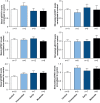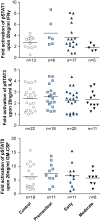JAK/STAT Signalling in Huntington's Disease Immune Cells
- PMID: 24459609
- PMCID: PMC3871417
- DOI: 10.1371/currents.hd.5791c897b5c3bebeed93b1d1da0c0648
JAK/STAT Signalling in Huntington's Disease Immune Cells
Abstract
Huntington's disease (HD) is an inherited neurodegenerative disorder caused by a CAG repeat expansion in the huntingtin (HTT) gene. Both central and peripheral innate immune activation have been described as features of the disease. Isolated human HD monocytes have been shown to produce more cytokines upon LPS stimulation compared to control monocytes. Understanding alterations in the signalling cascades responsible and activated by this increase in pro-inflammatory cytokine production is crucial in understanding the molecular basis of this phenomenon. Here we investigated the signalling cascade most commonly activated by pro-inflammatory cytokines such as IL-6 - the JAK/STAT signalling cascade. Using flow cytometry, we show that one out of three key transcription factors activated by JAK/STAT signalling is altered in primary human HD innate immune cells, suggesting that this pathway may only play a minor, additive role in the immune cell dysfunction in HD.
Figures




Similar articles
-
Laquinimod dampens hyperactive cytokine production in Huntington's disease patient myeloid cells.J Neurochem. 2016 Jun;137(5):782-94. doi: 10.1111/jnc.13553. Epub 2016 Apr 5. J Neurochem. 2016. PMID: 26823290 Free PMC article.
-
Microglial Activation in the Pathogenesis of Huntington's Disease.Front Aging Neurosci. 2017 Jun 19;9:193. doi: 10.3389/fnagi.2017.00193. eCollection 2017. Front Aging Neurosci. 2017. PMID: 28674491 Free PMC article. Review.
-
Multiple clinical features of Huntington's disease correlate with mutant HTT gene CAG repeat lengths and neurodegeneration.J Neurol. 2019 Mar;266(3):551-564. doi: 10.1007/s00415-018-8940-6. Epub 2018 Jun 28. J Neurol. 2019. PMID: 29956026 Review.
-
Inflammatory changes in peripheral organs in the BACHD murine model of Huntington's disease.Life Sci. 2019 Sep 1;232:116653. doi: 10.1016/j.lfs.2019.116653. Epub 2019 Jul 11. Life Sci. 2019. PMID: 31302194
-
Enhanced immune response to MMP3 stimulation in microglia expressing mutant huntingtin.Neuroscience. 2016 Jun 14;325:74-88. doi: 10.1016/j.neuroscience.2016.03.031. Epub 2016 Mar 23. Neuroscience. 2016. PMID: 27033979
Cited by
-
The choreography of neuroinflammation in Huntington's disease.Trends Immunol. 2015 Jun;36(6):364-73. doi: 10.1016/j.it.2015.04.007. Epub 2015 May 20. Trends Immunol. 2015. PMID: 26001312 Free PMC article. Review.
-
Neural and mesenchymal stem cells in animal models of Huntington's disease: past experiences and future challenges.Stem Cell Res Ther. 2015 Dec 14;6:232. doi: 10.1186/s13287-015-0248-1. Stem Cell Res Ther. 2015. PMID: 26667114 Free PMC article. Review.
-
RNA-Seq of Huntington's disease patient myeloid cells reveals innate transcriptional dysregulation associated with proinflammatory pathway activation.Hum Mol Genet. 2016 Jul 15;25(14):2893-2904. doi: 10.1093/hmg/ddw142. Epub 2016 May 11. Hum Mol Genet. 2016. PMID: 27170315 Free PMC article.
-
Recombinant human erythropoietin and interferon-β-1b protect against 3-nitropropionic acid-induced neurotoxicity in rats: possible role of JAK/STAT signaling pathway.Inflammopharmacology. 2022 Apr;30(2):667-681. doi: 10.1007/s10787-022-00935-x. Epub 2022 Mar 6. Inflammopharmacology. 2022. PMID: 35249177 Free PMC article.
-
Enhanced Neuroprotection in Experiment Multiple Sclerosis through Combined Rosiglitazone and Probiotic-loaded Solid Lipid Nanoparticles: Modulation of Cellular Signaling Pathways.CNS Neurol Disord Drug Targets. 2025;24(4):285-324. doi: 10.2174/0118715273336107241015100912. CNS Neurol Disord Drug Targets. 2025. PMID: 39492769
References
-
- Bates G, Harper PS, Jones L, editors (2002) Huntington's Disease. Oxford: Oxford University Press.
-
- Li SH, Schilling G, Young WS, Li XJ, Margolis RL, et al. (1993) Huntington's disease gene (IT15) is widely expressed in human and rat tissues. Neuron 11: 985-993. - PubMed
-
- van der Burg JM, Björkqvist M, Brundin P (2009) Beyond the brain: widespread pathology in Huntington's disease. Lancet Neurol 8: 765-774. - PubMed
LinkOut - more resources
Full Text Sources
Other Literature Sources

